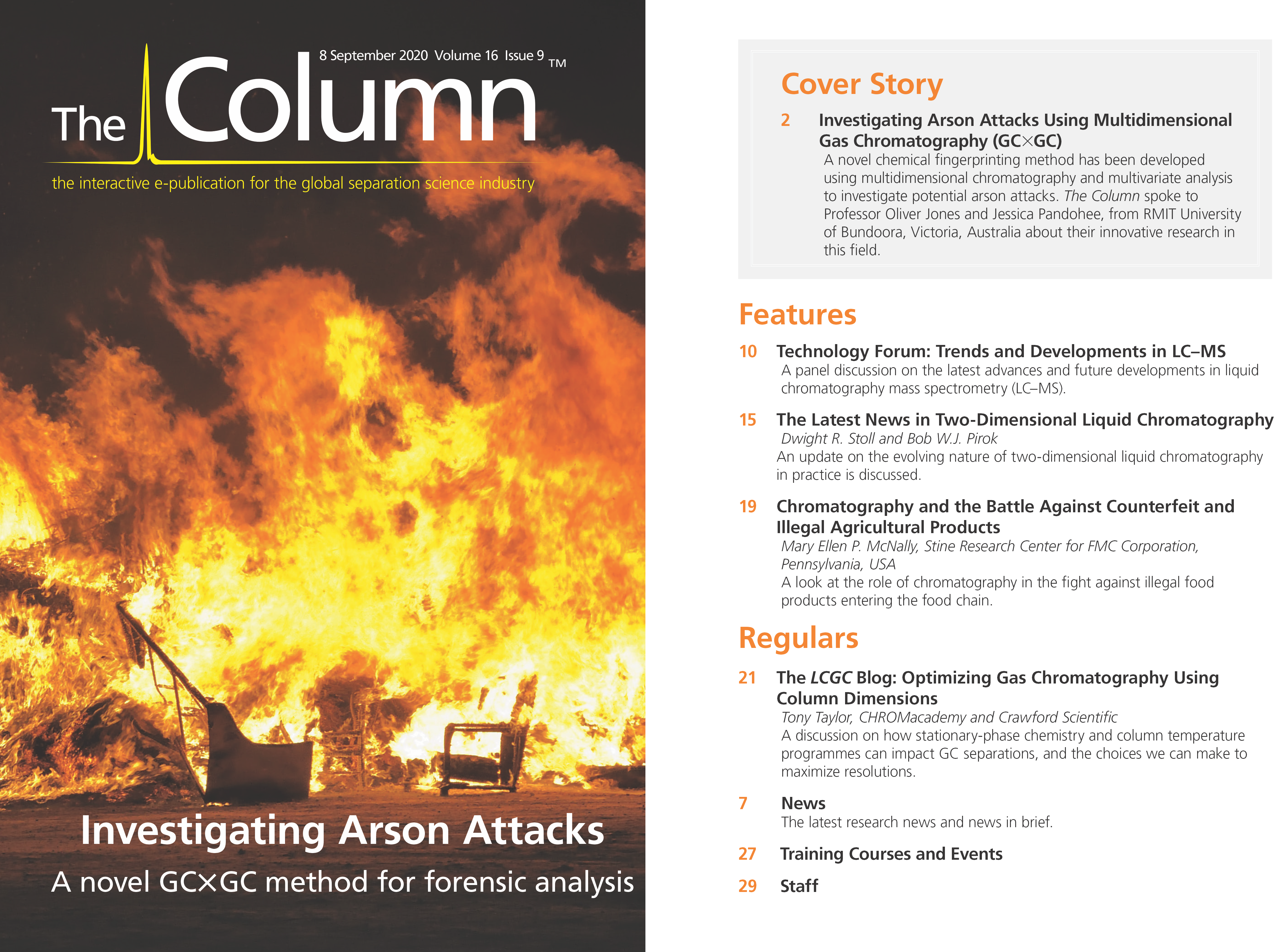Trends and Developments in LC–MS
A panel discussion on the latest advances and future developments in liquid chromatography mass spectrometry (LC–MS).
alexkich/stock.adobe.com

Q. What trends do you see emerging in LC or LC–MS?
Robert Buco: Analytical liquid chromatography (LC) has been used as a tool in making decisions for quite a while, and as the need to improve the efficiency, defensibility, and clarity of critical decision‑making processes continues to grow, there is an increasing focus on the question the scientist is asking, the analytical data they need, and ultimately the decision they are trying to make. This is driving a shift in LC users’ requirements of their systems, where the advances of technical specifications used to be the most important consideration, it has now been surpassed by reliability, reproducibility, and most importantly, usability. There are many trends in technology that are associated with this high-level need, including the increased desire for automated workflows encompassing pre-analytical, data acquisition, data processing, and reporting components as a way to help minimize the variability of results generated by different users, but I think the more important trend is in the user population. LC separation technology that was once only accessible to expertly trained scientists is now routinely used by a new generation that trusts and expects the technology to function for their purpose so they can focus on the results and what they mean.
Carsten Paul: I see a couple of key trends in the industry. First is the increasing utilization of ultrahigh-performance liquid chromatography (UHPLC) applications, with HPLC instruments remaining as the leading instruments in the market. In discovery and research, UHPLC is more prominent. However, as methods are transitioned to routine laboratories, the technology used is typically more “fit-for-purpose” HPLC. Second, the growing importance of mass spectrometry to characterize more complex biotherapeutic molecules, with implementation moving more into routine laboratories. The increasing shift in focus of pharmaceutical companies towards novel biologic medicines will direct the future development of analytical equipment to fulfil the complex characterization needs of these advanced therapies.
Stephane Moreau: Ultra-fast mass spectrometry (UFMS) improves the workflow and speed of analysis for routine testing laboratories. With the introduction of tandem LC–MS with fast polarity switching and high-speed analysis, the bottleneck of analysis has moved to sample preparation and data processing/reviewing. As a result of the lack or the cost of manpower, many laboratories are now seeking to automate the sample preparation stage. That means automating QuEChERS workflow in the field of food safety and automatic pretreatment of biological fluids in the clinical field. On the other side, the speed of analysis is now generating a huge amount of data that needs to be reprocessed and reviewed. Here, the penetration of artificial intelligence (AI) is starting to help bring analytical intelligence to the laboratory.
Rohit Shroff: Increasing separation efficiencies with lower column backpressures as well as faster run-times continue to drive the adoption of LC and LC–MS, particularly in the pharmaceutical/biopharmaceutical market. Biomolecular analysis, post-translational modifications, and large biotherapeutic characterization are driving innovation in separation chemistries by several key vendors. Significant advances have been made in stationary phase development. Silica-based columns are still predominant, however, novel therapeutic characterization needs have driven the development of core–shell materials and monolith packings. Development of micro- and nanobore columns have allowed the detection of extremely low abundant molecules, particularly peptides in biological matrices. Other recent trends include development of affinity and chiral chromatography. Increasing adoption of HPLC in the clinical market has also seen vendors launch a general purpose and class 1 medical device range of instruments. Emerging applications, such as the recent demand for cannabis testing are also driving developments in the HPLC, thin‑layer chromatography (TLC), and gas chromatography (GC) market.
Q. What is the future of LC or LC–MS?
Robert Buco: One of the strongest trends in analytical LC is a shift towards increasingly easy-to-use instrumentation that enables anyone, regardless of experience, to use the technology correctly and produce reliable results. I believe the future will be defined by this shift, where advances in technical specifications and raw chromatographic performance will become expected of any system, and innovation will be judged on the metrics of usability and customer experience.
Carsten Paul: As the application area of LC and LC–MS grows, there is a greater demand for reducing the complexity of the instrumentation. Scientists need to focus on accomplishing their research or adhering to relevant regulatory guidelines rather than spending valuable time and resources on showing people how to run the instruments and interpret the data. I would envision that in the future, an operator of any experience can easily run an analysis and the software can automatically report the results needed—regardless of whether that is a structural characterization, the location of a post‑translation modification, or the quantification of a toxic compound.
Stephane Moreau: In the clinical field, there is clearly an increase in the switch from immunoassays to LC–MS technologies. The better selectivity, sensitivity, and accuracy of analysis coupled with multiplexing capabilities and less risk of cross-reactions give LC–MS/MS a clear advantage in therapeutic drug monitoring as well as for toxicology and forensic applications. The penetration was somehow limited by the lack of automated sample preparation systems, but the recent launch of automated LC–MS systems is opening the door for a switch. The next step is to move for a more compact system fully automated and connected to an automated laboratory system. A similar tendency will also come to food safety analysis.
Rohit Shroff: We should see continued miniaturization of chromatography systems to increase sensitivity and separation efficiency at lower volumes. As systems get more affordable, increasing adoption should be seen for routine analysis. Demand from bioprocessing would drive innovation in prepacked, disposable columns as well as membrane technology. There will likely be continued development of novel stationary phases, such as miniaturized monolithic columns, unique bonded-silica phases, and polymeric stationary phases that offer better separations in high‑throughput analyses. The need for faster analyses, particularly in pharmaceutical research, will drive further developments and commercialization in the near future. Downstream processing in biopharmaceuticals will continue to drive improvements in two-dimensional (2D)‑LC as well as continuous chromatography technology. Overall, LC–MS will continue to see innovation driven by biotherapeutic research and industry needs.
Q. What is the LC or LC–MS application area that you see growing the fastest?
Robert Buco: Certainly, there are trends that point towards the need for more comprehensive solutions in the analysis of biopharmaceuticals. The analysis of intact proteins and oligonucleotides, monoclonal antibody subunits, released N-Glycans, and peptide mapping/multi-attribute monitoring (MAM) applications are all growing quickly. However, I think there are other application needs that are growing quickly and more quietly, particularly in materials science where there is a clear need for better characterization tools for complex polymer systems.
Carsten Paul: As already seen over the past couple of years, there is a tremendous shift in the pharmaceutical industry away from small molecule based active ingredients and towards biologic therapies, especially complex formats such as multispecific antibodies, drug conjugates, oligonucleotide‑based, as well as cell and gene therapies. These will require various characterization technologies, which need to be transferrable from the initial development stage through to manufacturing.
Stephane Moreau: The biggest one remains in food analysis, where the needs are mainly driven by the new regulations or the change of existing guidelines such as the Direction Générale de la Santé et des Consommateurs (DG-SANCO). The political pressure linked to random and/or recurrent scandals also boost development of applications in those fields. We have seen, for example, many interests for pyrrolizidine alkaloids recently, but multiresidue pesticides remain the mainstream. The second one would be the clinical field with penetration of MS technologies, not only LC–MS, for many areas, such as therapeutic drug monitoring, oncology, microbiology, and more.
Rohit Shroff: Biotherapeutic characterization in research as well as the biopharmaceutical industry is currently the fastest growth driver for LC and LC–MS technologies. Advances in columns, stationary phases, detectors, injection devices, as well as the improvements in chromatography methodology, are all leading to an exceeding number of applications, particularly in the pharmaceutical and biopharmaceutical sectors. Examples include: monoclonal antibody characterization, antibody–drug conjugates, DNA/RNA detection and modifications, quality control and process, or analytical technology in bioprocessing applications.
Q. What obstacles stand in the way of LC or LC–MS development?
Robert Buco: One of the technical obstacles relates to the compromise that often exists between the size of an instrument and its technical performance. If analytical LC instruments are to become fully integrated into automated processes and enable real‑time decision-making that impacts process control, they must be located in very close proximity to the point of analytical need, which in turn imposes restrictions on the physical size of the system as well as its robustness to be used in manufacturing environments. Developing an easy-to-use LC system that is sufficiently small, preserves the chromatographic capabilities of traditional systems, and offers an unparalleled level of usability while reliably running in continuous operation environments is a significant challenge, but I believe it is one our customer base is calling for and one our industry is ready to accept.
Carsten Paul: Some of the challenges are simply moving advanced detection and characterization methods, such as mass spectrometry, into a more routine usage. The instrument-to-instrument reproducibility, analytical precision, and accuracy tend to have wider tolerances than optical detectors, such as UV or DAD. In addition, transitioning mass spectrometry from a high-end research tool to a routine characterization method will require a great deal of simplicity in how the users interact with and optimize the methodologies that require this powerful technique. In addition, many questions remain unanswered when considering LC–MS application in highly regulated environments. This includes, for example, transferability between different instruments and vendors, data handling, product support, and product life cycle, as well as connectivity into a compliant ready, software network. Steps are being taken to address these challenges today, but will continue to take some time before they are fully embraced within the regulated laboratory environment.
Stephane Moreau: Currently, there are not so many improvements in sensitivity as a result of the difficulties for suppliers to improve the ionization efficiency. Thus, most developments are focused on the other bottlenecks mentioned earlier, that is, automation, easy reviewing/reprocessing using artificial intelligence software, and improved robustness. The request for more compact systems is also challenging because it leads to a compromise between sensitivity and size. For the clinical field, the future in vitro diagnostic regulation (IVDR) regulation is likely to transform the landscape.
Rohit Shroff: Speed of analysis continues to be a limiting factor for chromatography‑based hyphenated techniques, particularly in high‑throughput drug discovery applications. Although considered a highly sensitive technique, for large molecule applications LC–MS sensitivity can be challenging compared with traditional ligand binding techniques. The high costs of chromatography instruments and reagents continues to be a deterrent for laboratories to invest in expensive equipment, unless the end product is of high value, such as a biotherapeutic. Coelution, sample adsorption, performance over a wide pH range, matrix complexity, robust method development for novel therapeutics, and high‑skill requirements for efficiently running LC–MS laboratories are other obstacles.
Q. What was the biggest accomplishment or news in 2019/2020 for LC or LC–MS?
Robert Buco: For me, the biggest news was the ICH Q12 Guideline on Technical and Regulatory Considerations for Pharmaceutical Product Life Cycle Management and its annexes reaching step 4 of the ICH Process. There has been an increased focus on life cycle management for analytical methods in recent years from the industry’s regulatory bodies, resulting in a more harmonized approach to technical and regulatory considerations for method life cycle management. When paired with analytical quality by design (AQbD), method life cycle management is set to change the way the pharmaceutical industry brings products to market, by ensuring the development of more robust analytical methods that result in more consistent, reliable, and high-quality data. The eventual implementation of Q12 will promote innovation and continual improvement in the biopharmaceutical sector, strengthen quality assurance, and improve the reliability of product supply.
Carsten Paul: With the analytical demands of scientists, who are often working with challenging analytes in complex sample matrices, the implementation of advanced LC and LC–MS instrumentation through 2019/2020 has helped to meet their needs and expanded their capabilities. This continual improvement is crucial to ensure scientists are able to conduct their work, uninhibited by their equipment.
Rohit Shroff: 2019 saw continued focus on developing stationary phases/column chemistries, particularly to meet the needs in pharmaceutical, biopharmaceutical analysis, and quality control (QC). For small molecule separations, numerous reverse‑phase and HILIC chemistries on both superficially porous particle (SPP) and fully porous particle (FPP) architectures were developed. Stationary phases for large molecules had a focus on reversed-phase SPP architecture. Another interesting trend was the introduction of aromatic stationary phases that offered increased sensitivity and could be used with highly aqueous mobile phases for the analysis of polar compounds. 2019 also saw the continued development of new, compact, and hybrid LC–MS systems from key vendors.

Robert Buco is the Director of Global Product Management of LC Systems at Waters Corporation.

Carsten Paul is a UHPLC Product Marketing Manager at Thermo Fisher Scientific.

Rohit Shroff is the Senior Director of LC–MS Strategy and Portfolio Management at VWR, Part of Avantor.

Stephane Moreau is a LC–MS and Life Sciences Manager at Shimadzu Europa.

Common Challenges in Nitrosamine Analysis: An LCGC International Peer Exchange
April 15th 2025A recent roundtable discussion featuring Aloka Srinivasan of Raaha, Mayank Bhanti of the United States Pharmacopeia (USP), and Amber Burch of Purisys discussed the challenges surrounding nitrosamine analysis in pharmaceuticals.
Silvia Radenkovic on Building Connections in the Scientific Community
April 11th 2025In the second part of our conversation with Silvia Radenkovic, she shares insights into her involvement in scientific organizations and offers advice for young scientists looking to engage more in scientific organizations.

.png&w=3840&q=75)

.png&w=3840&q=75)



.png&w=3840&q=75)



.png&w=3840&q=75)








